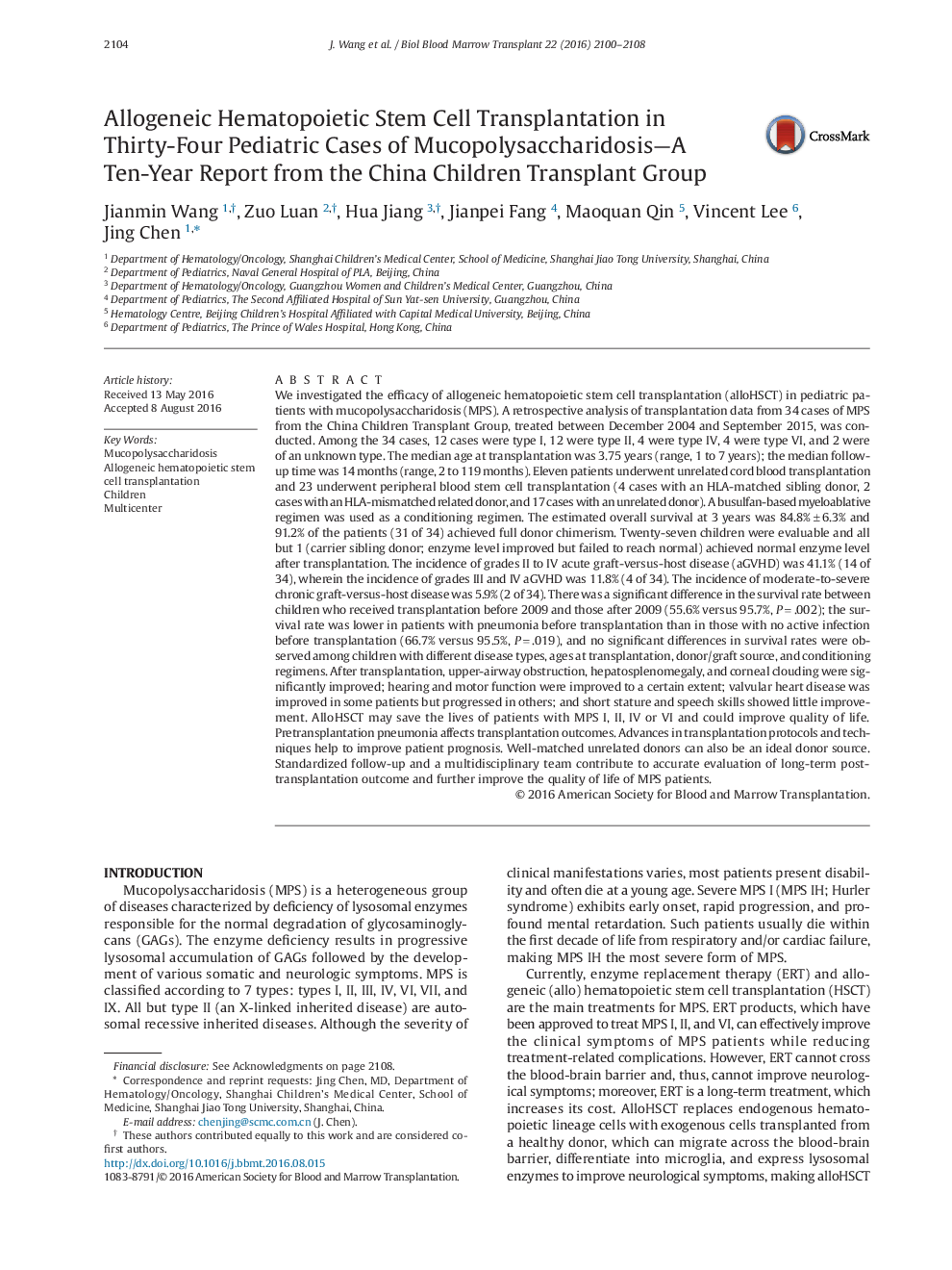| Article ID | Journal | Published Year | Pages | File Type |
|---|---|---|---|---|
| 5524163 | Biology of Blood and Marrow Transplantation | 2016 | 5 Pages |
â¢We reported multicenter results of allogeneic hematopoietic stem cell transplantation for mucopolysaccharidosis throughout Chinaâ¢This study included not only mucopolysaccharidosis IH but also other types that were reported rarelyâ¢Overall survival, full donor chimerism, and normal enzyme levels were high and transplantation-related mortality was lowâ¢Hematopoietic stem cell transplantation was helpful to improve multisystem symptoms of mucopolysaccharidosis
We investigated the efficacy of allogeneic hematopoietic stem cell transplantation (alloHSCT) in pediatric patients with mucopolysaccharidosis (MPS). A retrospective analysis of transplantation data from 34 cases of MPS from the China Children Transplant Group, treated between December 2004 and September 2015, was conducted. Among the 34 cases, 12 cases were type I, 12 were type II, 4 were type IV, 4 were type VI, and 2 were of an unknown type. The median age at transplantation was 3.75 years (range, 1 to 7 years); the median follow-up time was 14 months (range, 2 to 119 months). Eleven patients underwent unrelated cord blood transplantation and 23 underwent peripheral blood stem cell transplantation (4 cases with an HLA-matched sibling donor, 2 cases with an HLA-mismatched related donor, and 17 cases with an unrelated donor). A busulfan-based myeloablative regimen was used as a conditioning regimen. The estimated overall survival at 3 years was 84.8%â±â6.3% and 91.2% of the patients (31 of 34) achieved full donor chimerism. Twenty-seven children were evaluable and all but 1 (carrier sibling donor; enzyme level improved but failed to reach normal) achieved normal enzyme level after transplantation. The incidence of grades II to IV acute graft-versus-host disease (aGVHD) was 41.1% (14 of 34), wherein the incidence of grades III and IV aGVHD was 11.8% (4 of 34). The incidence of moderate-to-severe chronic graft-versus-host disease was 5.9% (2 of 34). There was a significant difference in the survival rate between children who received transplantation before 2009 and those after 2009 (55.6% versus 95.7%, Pâ=â.002); the survival rate was lower in patients with pneumonia before transplantation than in those with no active infection before transplantation (66.7% versus 95.5%, Pâ=â.019), and no significant differences in survival rates were observed among children with different disease types, ages at transplantation, donor/graft source, and conditioning regimens. After transplantation, upper-airway obstruction, hepatosplenomegaly, and corneal clouding were significantly improved; hearing and motor function were improved to a certain extent; valvular heart disease was improved in some patients but progressed in others; and short stature and speech skills showed little improvement. AlloHSCT may save the lives of patients with MPS I, II, IV or VI and could improve quality of life. Pretransplantation pneumonia affects transplantation outcomes. Advances in transplantation protocols and techniques help to improve patient prognosis. Well-matched unrelated donors can also be an ideal donor source. Standardized follow-up and a multidisciplinary team contribute to accurate evaluation of long-term post-transplantation outcome and further improve the quality of life of MPS patients.
